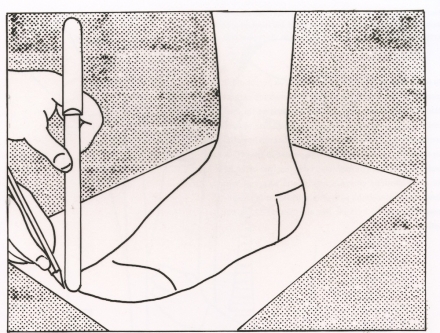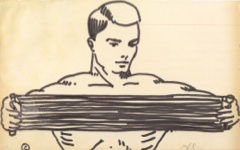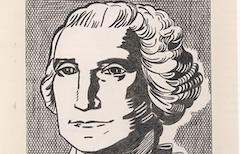Lichtenstein’s Mail-Order Foot (1961)

Lichtenstein, Mail-Order Foot (1961) Pochoir, pen and ink on paper. The Sonnabend Collection.
Click image to enlarge.
Roy Lichtenstein's early drawings in a Pop mode have fairly obvious references to art itself. He made this large drawing, for example, from a tiny clipping found inside his studio, the exact purpose of which is unclear.
Click next thumbnail to continue

Untitled loose clipping found in Roy Lichtenstein's studio. Source unidentified. The Roy Lichtenstein Foundation Archives.
Click image to enlarge.
The source shows a foot being traced on a piece of paper using a pencil and knife with instructions on how to do it underneath.
Click next thumbnail to continue
Enlarging this image over 600 times the artist drew an image resembling a print, the source's medium not the drawing's. Nevertheless it is clear that "the subject of this drawing is emblematic of the act of drawing itself" as a curator noted.1 Another specialist, Graham Bader, remarked "the line being traced appears to be making the very foot it is outlining, directly equating the act represented with that of Lichtenstein's own process in making the image."2
Click next thumbnail to continue
Hands, perhaps the artist's, use a pencil with a knife, the pencil's common but little known visual synonym.3 In holding both Lichtenstein conveys his knowledge of art's self-referential allegory as revealed on EPPH. Bader even notes that painting and drawing during the 1960's "were increasingly understood....as something like a thumbprint" of the artist's interior state. Of course, artists always thought of art-making that way; it was writers who changed their minds.4
Click next thumbnail to continue

Lichtenstein, Foot Medication (1962) Frottage and graphite pencil on paper. Menil Collection, Houston
Click image to enlarge.
With experience Lichtenstein's references to art became more subtle. In a related drawing, Foot Medication made the next year, much remains the same even if its link to art becomes less obvious...and, thus, more poetic.
For an analysys of Lichtenstein's Foot Medication (1962), click here.
More Works by Lichtenstein
Notes:
1. Isabelle Dervaux, "Mail-Order Foot, 1961" in Roy Lichtenstein: The Black-and-White Drawings 1961-1968 (New York: The Morgan Library) 2011, p. 88
2. Bader, "Drawing Touch" in Roy Lichtenstein: The Black-and-White Drawings 1961-1968, op. cit., p.46
3. Knives, swords, daggers and other sharp instruments are common visual metaphors in art not only for a pencil but for paintbrushes, palette-knives and burins as well, even a sculptor's chisel. Dozens of examples by numerous great artists are included in the theme Swords/Weapons as Brushes.
4. As I regularly explain artists have always depicted scenes inside their minds even when they were labelled as Realists or Impressionists. From at least the early Renaissance onwards the scenes in great art depict in metaphorical form the visual and artistic processes at work in the mind of the artist.
5. Bader, ibid., p. 47
Original Publication Date on EPPH: 04 Mar 2013. | Updated: 0. © Simon Abrahams. Articles on this site are the copyright of Simon Abrahams. To use copyrighted material in print or other media for purposes beyond 'fair use', you must obtain permission from the copyright owner. Websites may link to this page without permission (please do) but may not reproduce the material on their own site without crediting Simon Abrahams and EPPH.




